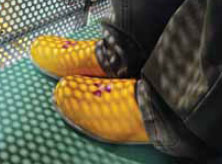Treading lightly in Tokyo
 |
It was my first morning in Tokyo. Carrying a camera, an offering of saké, and a note in Japanese that I hoped explained why I was there, I stepped into the sumo training hall to watch the days practice.
Even with my limited knowledge of the language, I understood immediately that I had done something wrong. A short, thin man sprinted toward me, waving his arms and exclaiming in protest.
He motioned toward my feet. My cheeks burned. I realized I had committed the sin of dosoku—wearing my street shoes inside.
In Japan, people remove their shoes and sometimes change into slippers before entering homes, temples, traditional restaurants and, apparently, sumo training halls. I was surprised to discover later that this list also includes certain areas of physics laboratories.
At Japan's high-energy physics laboratory KEK, employees and visitors change into rubber sandals before entering the control room for the B-factory accelerator, KEKB. Kyoto University staff members ask people who go near their accelerators to wear bright yellow clogs.
 |
| Photos: Kathryn Grim |
Kazuo Abe of Tokyo's Institute for the Physics and Mathematics of the Universe explained in an e-mail that only a small number of laboratories enforce the tradition, which most Japanese learn in elementary school. "They do so more out of a respect for the custom than to keep the place clean," he wrote. "We mostly go along without arguing."
Youhei Morita of KEK explained the practice this way: "Traditional Japanese regard [outdoor shoes] as carrying the impurity of the outside world, and it becomes almost our second nature to take them off at the entrance."
Perhaps its a good metaphor for scientists, who seek the truth uncolored by the expectations of the world around them.
Kathryn Grim
Click here to download the pdf version of this article.






